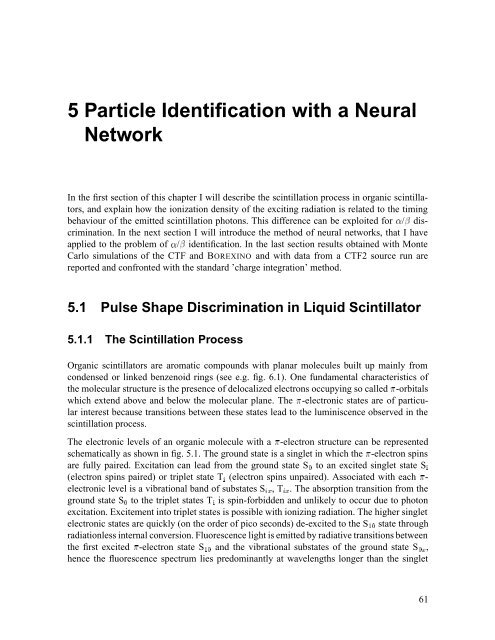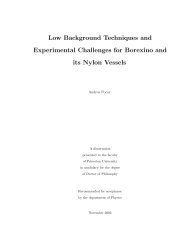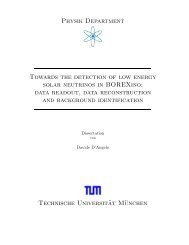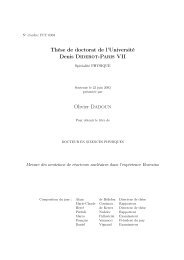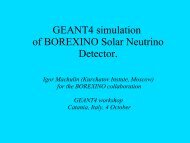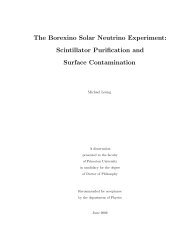Development of a Liquid Scintillator and of Data ... - Borexino - Infn
Development of a Liquid Scintillator and of Data ... - Borexino - Infn
Development of a Liquid Scintillator and of Data ... - Borexino - Infn
Create successful ePaper yourself
Turn your PDF publications into a flip-book with our unique Google optimized e-Paper software.
5 Particle Identification with a Neural<br />
Network<br />
In the first section <strong>of</strong> this chapter I will describe the scintillation process in organic scintillators,<br />
<strong>and</strong> explain how the ionization density <strong>of</strong> the exciting radiation is related to the timing<br />
behaviour <strong>of</strong> the emitted scintillation photons. This difference can be exploited for «/¬ discrimination.<br />
In the next section I will introduce the method <strong>of</strong> neural networks, that I have<br />
applied to the problem <strong>of</strong> «/¬ identification. In the last section results obtained with Monte<br />
Carlo simulations <strong>of</strong> the CTF <strong>and</strong> BOREXINO <strong>and</strong> with data from a CTF2 source run are<br />
reported <strong>and</strong> confronted with the st<strong>and</strong>ard ’charge integration’ method.<br />
5.1 Pulse Shape Discrimination in <strong>Liquid</strong> <strong>Scintillator</strong><br />
5.1.1 The Scintillation Process<br />
Organic scintillators are aromatic compounds with planar molecules built up mainly from<br />
condensed or linked benzenoid rings (see e.g. fig. 6.1). One fundamental characteristics <strong>of</strong><br />
the molecular structure is the presence <strong>of</strong> delocalized electrons occupying so called -orbitals<br />
which extend above <strong>and</strong> below the molecular plane. The -electronic states are <strong>of</strong> particular<br />
interest because transitions between these states lead to the luminiscence observed in the<br />
scintillation process.<br />
The electronic levels <strong>of</strong> an organic molecule with a -electron structure can be represented<br />
schematically as shown in fig. 5.1. The ground state is a singlet in which the -electron spins<br />
are fully paired. Excitation can lead from the ground state S to an excited singlet state S<br />
(electron spins paired) or triplet state T (electron spins unpaired). Associated with each electronic<br />
level is a vibrational b<strong>and</strong> <strong>of</strong> substates SÜ, TÜ. The absorption transition from the<br />
ground state S to the triplet states T is spin-forbidden <strong>and</strong> unlikely to occur due to photon<br />
excitation. Excitement into triplet states is possible with ionizing radiation. The higher singlet<br />
electronic states are quickly (on the order <strong>of</strong> pico seconds) de-excited to the S state through<br />
radiationless internal conversion. Fluorescence light is emitted by radiative transitions between<br />
the first excited -electron state S <strong>and</strong> the vibrational substates <strong>of</strong> the ground state S Ü,<br />
hence the fluorescence spectrum lies predominantly at wavelengths longer than the singlet<br />
61


